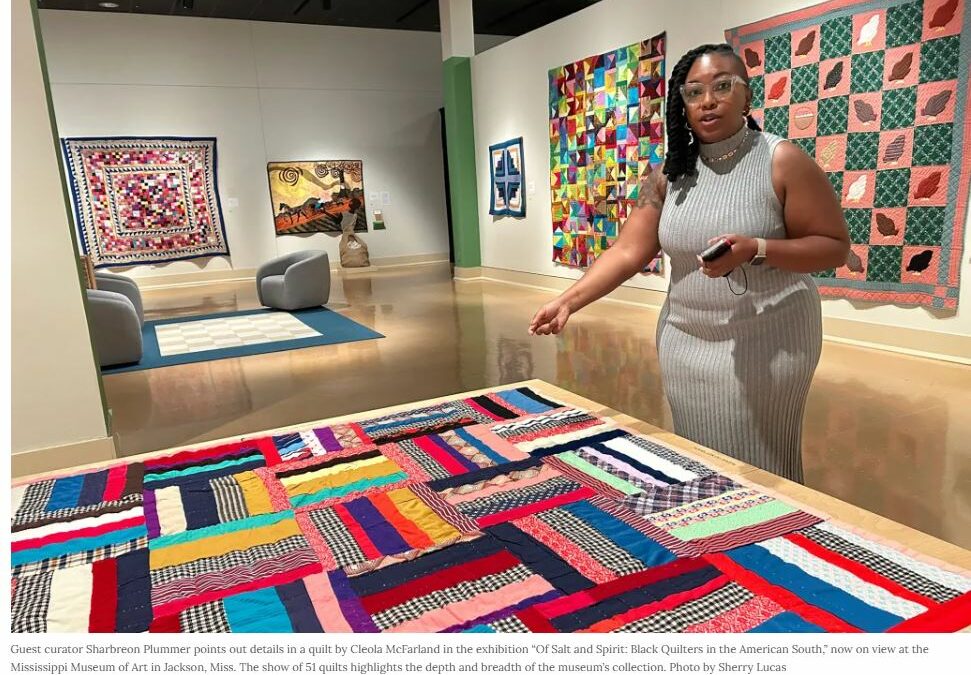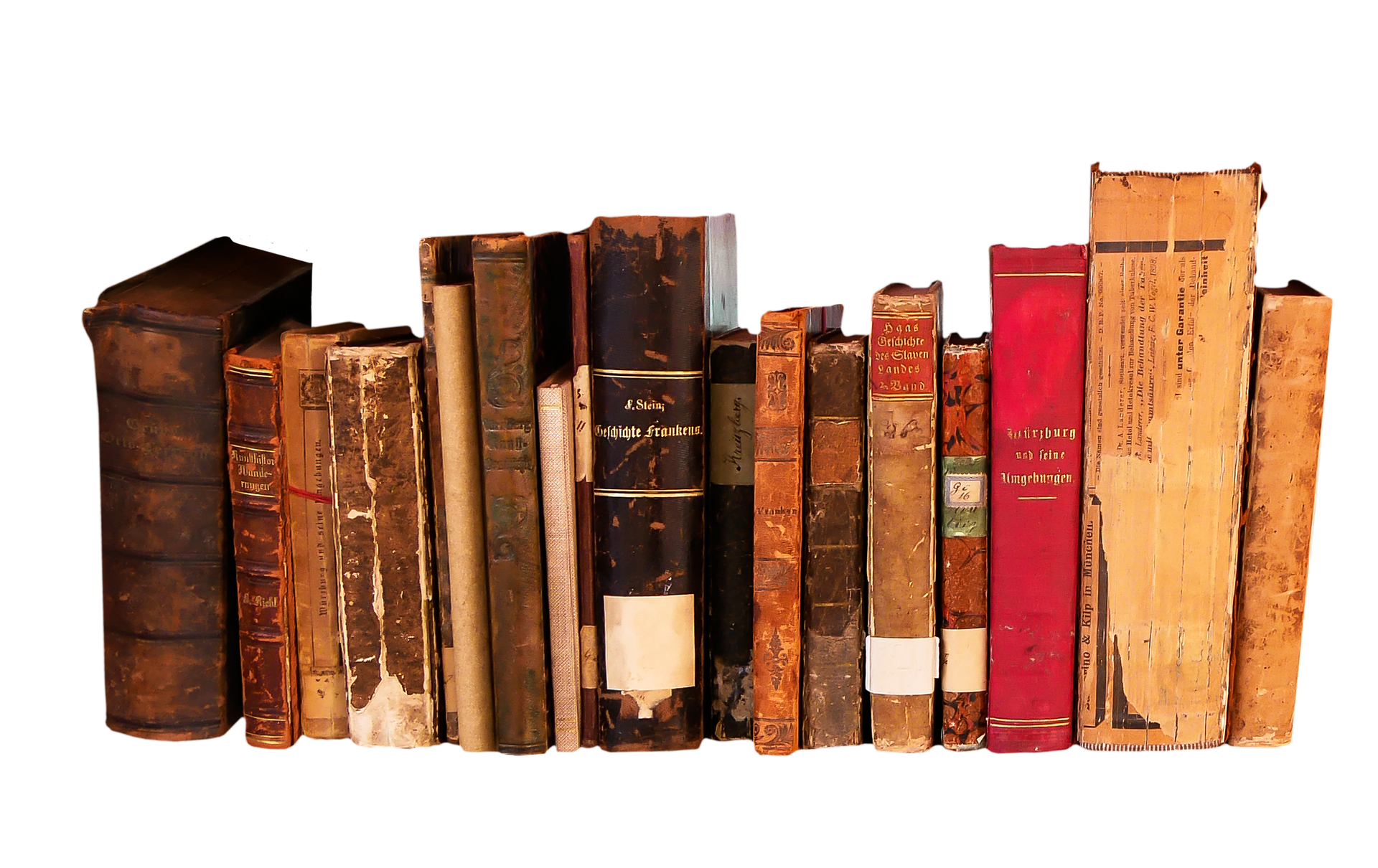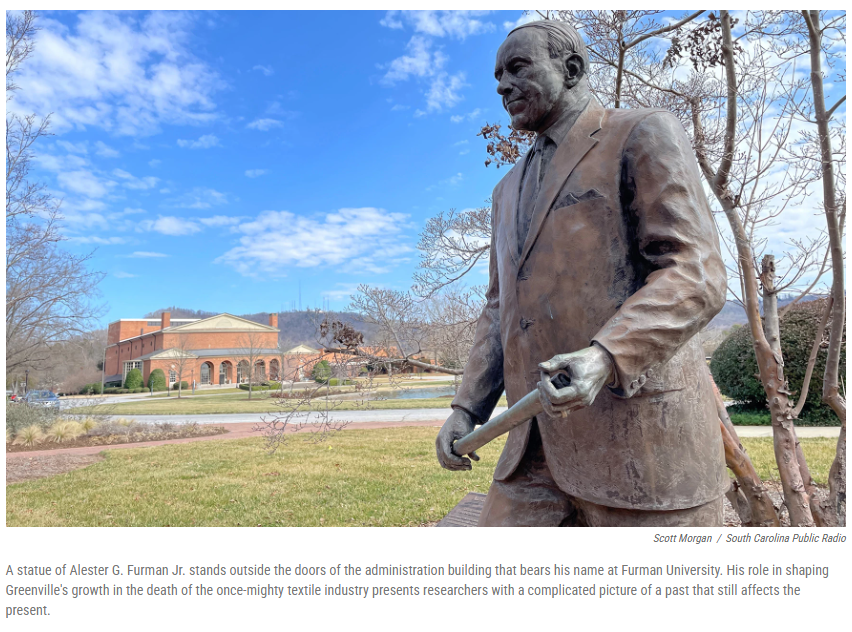Sharbreon Plummer fondly gazed down at Cleola McFarland’s 1974 “Throw-together Quilt,” wearing the sort of smile you’d use to greet an old friend. The quilt lay flat on a bed-height platform in the center of the gallery at the Mississippi Museum of Art in Jackson, Miss., landing both a bold artistic punch and a psychic shortcut to home.
“I love this work. … Phenomenal quilter,” said Plummer, Ph.D., researcher, educator, artist and guest curator of the new exhibition “Of Salt and Spirit: Black Quilters in the American South.” The phrase “Of Salt and Spirit” within the title comes from Alabama Poet Laureate Ashley M. Jones’ poem, “I Cannot Talk about the South without Talking about Black Women.”
The exhibition, continuing through April 15, 2025, at the MMA, features more than 50 quilts from the museum’s permanent collection. Bold creations by Crossroads Quilters, provocative and emotional works by late Jackson artist Gwendolyn Magee and a host of quilts collected by late photo documentarian Roland L. Freeman that the museum acquired in 2022 are among the many highlights.
“She has such a command of color,” Plummer said of quilter McFarland and the way vivid fabric strips come together for such lively effect in her creations. “It tells a story of time. … There are so many different materials that are reminiscent of that decade.” The plaids, knits, polyester, corduroy, a groovy stripe and a telling motif remind Plummer of the ’70s when she looks at it, she added.
“I want to tell a story of not just place, but time,” the curator said. “I’m curious to see what folks will think when they see patterns like this, ones that are so distinct to the era.”

Upon a closer inspection, a small hole and minor stain reveal themselves on the quilt. “I appreciate (those imperfections). To me, it shows the use. It shows that these were things that were well-loved, and I don’t shy away from displaying that,” Plummer said. The quilt’s flat presentation works as well for its preservation as its intimate, immediate effect on its audience. “It invites the viewer in to see all of it in its glory.”
Everyday Women Turned Archivists
Originally from Baton Rouge, La., and now based in Chicago, Plummer brought a familial connection to quilts and a broader love of textiles to the project. “I often say quilts find me and they’re very selfish, so once you’re in them, you can’t separate,” she said with a grin. This exhibition explores the stories, traditions and community ties that quilters immortalized through a Black feminist lens.
“Black women in the South have been making quilts for generations and have demonstrated through their making, their power, their love, their connection to generations of women who came before them, and will come after them,” Mississippi Museum of Art Director Betsy Bradley said. In this exhibition, those women’s strength comes through in design, narrative and brilliant, bold expression.

The museum’s quilt collection, built over the last 20 years, doubled in size in 2022 with a gift from the Kohler Foundation that included 131 quilts from the personal quilt collection of folklife photo documentarian Roland L. Freeman. Several are included in this show, as well as a dozen of Freeman’s portraits of quilters, archive materials of his quilt projects and his video interview of legendary Mississippi quilter Hystercine Rankin, a 1997 NEA National Heritage Fellow.
Curating the exhibition was “a dream,” Plummer said, noting the inspiration of Freeman and his book “A Communion of the Spirits” as she worked on her dissertation on Black women’s work in textile traditions. Broad themes organize the show: Homecoming, to root viewers in the South as a home place and explore the origin of quilt practices; Gathering, about quilting as a collective practice; Aesthetics of Place, with a variety of techniques that challenge pigeonholing Black Southern quilts alongside Freeman’s work documenting Black Southern life; and Bound by Love, about quilting as an intergenerational practice.

Several threads remained top of mind as Plummer organized the show. Countering the historical misrepresentation of Black quilt making was one. As a researcher, she often came across 20th century and a few late 19th century scholars and writers who framed Black quilt making as an improvisational approach, as if that were the sole thing that defined it.
“As you can see from the show, there’s such a depth and a breadth, and improvisation is but one form,” Plummer said. “And, even when quilters improvise, it’s still coming from a place of skill, deep inspiration and just precision.”
“I wanted folks to understand that quilting isn’t just something that’s haphazard. It’s a very detailed aesthetic choice,” she continued.
Plummer also wants visitors to consider how they might have viewed Black quilt making and the quilters themselves. “Many of these women are from rural areas, folks you would see every day, but individuals that folks may not perceive as artists,” she said. “It’s important for me to celebrate the contributions of these women as artists, as everyday archivists and individuals who inspire so many.”
The majority of the quilts in the exhibit are from Mississippi, with additional selections from other states to represent the Southern region as a whole.

Artworks run the gamut, both visually and emotionally. Rather than a warm blanket of memory, Magee’s quilted art pieces deliver searing portraits of historical trauma. Her depictions of the cruelties of slavery in the American South, particularly for enslaved women, are powerful and haunting in their imagery, and in the unexpected find of hard truths in such a soft, tactile medium. A woman, anchored by a three-dimensional burlap cotton sack that stretches out of the frame and down to the floor, wails as a wagon drives away with her child. In another, an enslaved woman kneels, head bowed, as a white man removes his shirt.
Crossroads Quilters’ story is stitched into “Pieces and Strings — The First Ten Years,” commemorating its 1987 through 1997 start in patterns, techniques and visual nods to Mississippi Cultural Crossroads, which Patty Crosby founded in Port Gibson, and its network of Claiborne County quilters.

Rankin’s poignant “Memory Quilt” chronicles daily chores and rural recollections—her mother feeding chickens and churning butter, spring plowing and coon hunting, parents picking cotton while their swaddled baby rests on the cotton sack. In a stark reminder of earlier times, Black children walk to school while white kids ride the bus.
Funny and playful panels enliven Mary Mayfair Matthews’ “Folk Scenes,” a quilt of small town vignettes. “It is one of the few in the collection that features so many different materials,” Plummer said, pointing out the figures’ button eyes, use of lace, applique style and fun embellishments. The Tennessee quilter was also a doll-maker.
“All of these little figures and bodies are two-dimensional examples of what her dolls would have looked like,” she explained. “This is very much her style and aesthetic.”

Jumping rope, courting and walking the dog are just a few of the scenes, and the observant eye will be rewarded by a laugh-out-loud discovery. “Art education is my first love,” Plummer said, chuckling. “There’s going to be a kid—and I want to be here for it—who runs up and says, ‘Mommy, look!’
“There are just so many different elements that somebody could enjoy, and I thought it could be something wonderful for all ages,” Plummer continued. Matthews’ story struck her, too. “Although she considered herself somewhat of a creative person, art became a method of coping after she lost her son. … She is somebody whom I adored and (who) should be more celebrated.”
The exhibition ends with yet another visual stunner, the 1978 “Star Quilt” by Emma Russell of Louisiana. “When you stand back … that medallion center almost radiates,” Plummer said. The star pattern seems to pulse with energy, an effect of the diamond cut and the gradient of bright colors. Visitors cannot touch the quilts, of course, but a small quilted block beside “Star Quilt” can be handled. Flip it over for another stunner: The stitches are very tiny. A couple of exhibition quilts hang vertically in the gallery space, for viewers to see front and back so that they can get a closer look at the stitching.

–mississippifreepress.org
“Of Salt and Spirit”’s closing gallery also provides a space to reflect, with the honor wall “A Tapestry of Gratitude” and its prompts to share memories and feelings about the exhibition. “I imagine as people learn about these women and they see their photos and quilts, it invokes a lot,” Plummer said. “I wanted a space for individuals just to share and also to engage us in this practice of honoring the women and their lives. It can really be a beautiful endnote.”
As Plummer walked back into the galleries, she passed Yolanda Clay-Moore, Visit Jackson director of external affairs, who was strolling slowly through, taking in the show. “It’s beautiful,” Clay-Moore said, as if on cue. “It reminds me of my grandmother.”
Plummer smiled. “That’s what I was hoping for.”
Admission to view “Of Salt and Spirit: Black Quilters in the American South” is $15 for adults, $13 seniors 65-plus, $10 for children ages 5 through 17 and for college students. Admission is free for museum members and children 5 and younger. Admission is also free on the first Saturday of each month and for K-12 students on Tuesdays and Thursdays. Visit msmuseumart.org for more details.



